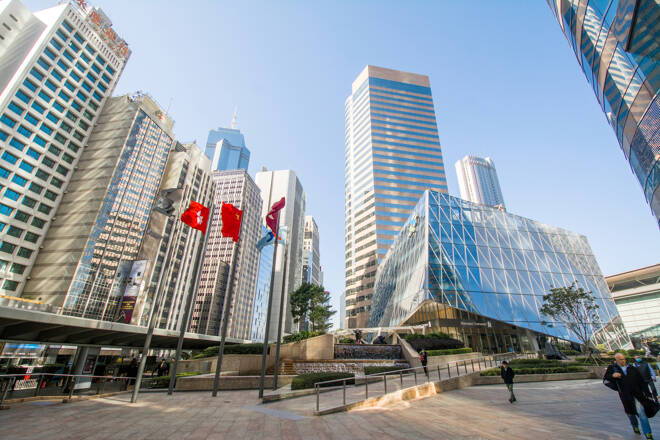Advertisement
Advertisement
Hang Seng Index, Nikkei 225, ASX 200: Markets Respond to US Inflation and Fed Outlook
By:
Key Points:
- On Thursday (June 13), the Hang Seng Index and the broader Asian equity markets made early gains.
- Overnight US inflation numbers and the FOMC economic projections influence market risk sentiment.
- Economic indicators from Australia and Japan also attracted investor attention.
US CPI Report and the Fed Influence Risk Sentiment
Overnight US inflation figures and the FOMC Economic Projections drove buyer demand for riskier assets.
The annual inflation rate fell from 3.4% to 3.3%, with core inflation down from 3.6% to 3.4%. Economists forecast rates of 3.4% and 3.5%, respectively.
Furthermore, the Fed stood pat on monetary policy. However, the economic projections were more hawkish, with upward revisions to PCE inflation and Federal Fund Rates.
Despite the upward revisions to inflation and Fed Funds Rate projections, 10-year US Treasury yields slid by 90 basis points to 4.316%. The softer-than-expected inflation numbers influenced market risk sentiment more.
On Wednesday (June 12), the Nasdaq Composite Index and the S&P 500 saw gains of 1.53% and 0.85%, respectively. However, the Dow bucked the trend, declining by 0.09%.
The US Futures had a mixed start to the Thursday (June 13) Asian session, with the Nasdaq mini rising by 119 points while the Dow mini fell by 31.
Softer US inflation numbers will likely set the tone for the Asian session. However, investors will likely be mindful of the more hawkish economic projections that left the Dow in the red.
On Thursday, economic indicators from Australia and Japan also warranted investor attention.
Moreover, concerns about the Chinese real estate market and economic outlook remain considerations. Investors should monitor stimulus chatter from Beijing and Bank of Japan comments regarding monetary policy.
Hang Seng Index and the Mainland China Markets Steady after Recent Reversals
The mainland China indexes kickstarted the Thursday session with early gains. On Thursday morning, the Shenzhen Composite Index and CSI 300 were up 0.15% and 0.10%, respectively.
The Hang Seng Index also started the day in positive territory, advancing by 0.39%.
Tech stocks advanced, tracking the Nasdaq Composite Index. The Hang Seng Tech Index (HSTECH) gained 0.31% in the morning session.
Alibaba (9988) rose by 0.07%. Baidu (9888) and Tencent Holdings (0700) saw gains of 0.71% and 1.08%, respectively.
However, real estate stocks limited the upside. The Hang Seng Mainland Properties Index (HSMPI) extended its losses from Wednesday, falling by 0.48%.
Nikkei Ignores the Stronger Yen on US Inflation Numbers
The Nikkei Index advanced by 0.12% in the Thursday morning session. A weaker USD/JPY limited the upside, as investors considered the combination of softer US inflation numbers and more hawkish FOMC economic projections.
BSI Large Manufacturing figures for Q2 2024 attracted investor interest early in the Thursday session. The BSI Large Manufacturing Index decreased 1.0% year-on-year in Q2 2024 after falling 6.7% in Q1 2024. Economists forecast a decline of 5.2%. The figures signaled an improving macroeconomic environment, albeit modestly, aligning with better-than-expected producer prices from Japan.
Softbank Group Corp (9984) rallied 1.90%, with Sony Group Corporation (6758) gaining 1.56%.
Retailing Co. Ltd. (9983) and KDDI Corp. (9433) saw gains of 0.47% and 0.21%, respectively.
However, Tokyo Electron Ltd. (8035) bucked the trend, falling by 0.48%.
ASX 200 Finds Tech Support
The ASX 200 advanced by 0.53% through the Thursday morning session.
Iron ore and gold spot (XAU/USD) ended the Wednesday session in positive territory, with WTI crude oil held onto the $78 handle. However, commodity price gains from Wednesday delivered a mixed morning session.
Bank stocks trended higher on Thursday morning. Commonwealth Bank of Australia (CBA) and National Australia Bank Ltd. (NAB) rose by 0.95% and 0.98%, respectively. ANZ Group Holdings Ltd. (ANZ) gained 0.47%, with Westpac Banking Corp. (WBC) up 0.52%.
Gold and tech stocks contributed to the early gains. Northern Star Resources Ltd. (NST) was flat, while Evolution Mining Ltd (EVN) advanced by 0.94%.
The S&P/ASX All Technology Index rallied 1.95%, tracking the Nasdaq Composite Index into positive territory.
However, mining and oil stocks limited the morning gains.
Fortescue Metals Group Ltd. (FMG) rose by 0.09%. BHP Group Ltd (BHP) and Rio Tinto Group Ltd. (RIO) declined by 0.56% and 0.48%, respectively.
Woodside Energy Group Ltd (WDS) and Santos Ltd (STO) saw losses of 1.24% and 0.20%, respectively.
Australian economic indicators had a limited impact on the ASX 200 despite tighter labor market conditions. Australian employment increased by 39,700 in May, with the unemployment rate falling from 4.1% to 4.0%. Economists forecast a 30,000 increase in employment and an unemployment rate of 4.0%. In April, employment rose by 38,500.
For upcoming economic events, refer to our economic calendar.
About the Author
Bob Masonauthor
With over 28 years of experience in the financial industry, Bob has worked with various global rating agencies and multinational banks. Currently he is covering currencies, commodities, alternative asset classes and global equities, focusing mostly on European and Asian markets.
Advertisement
